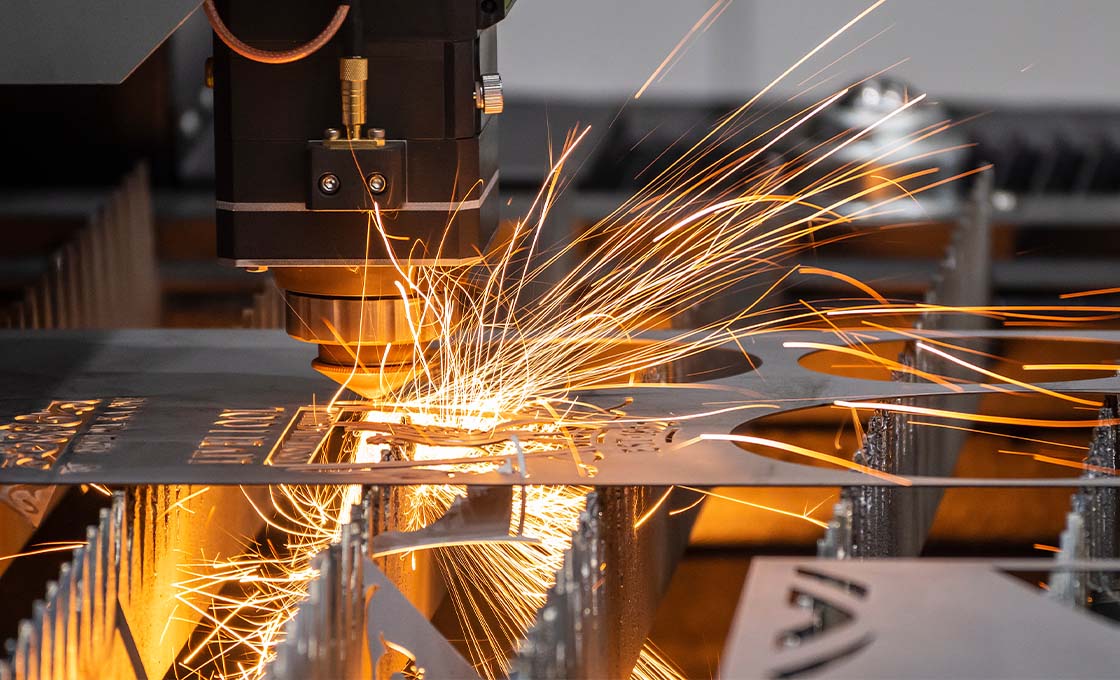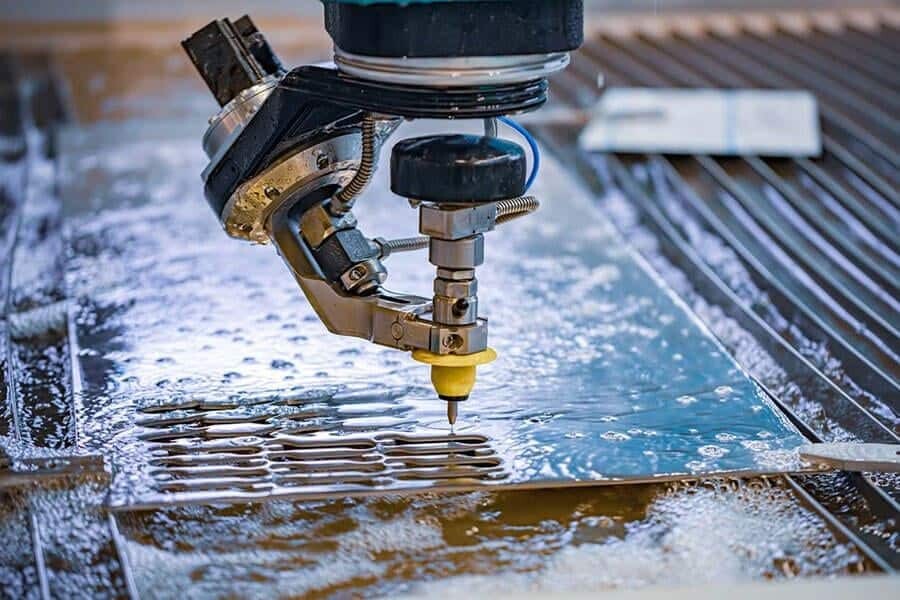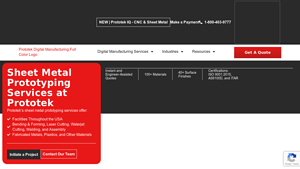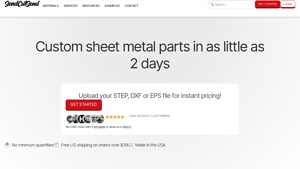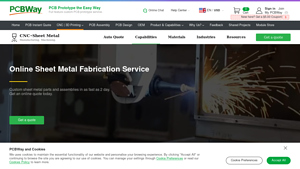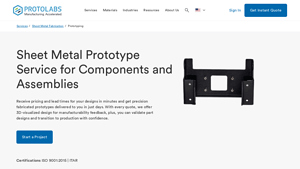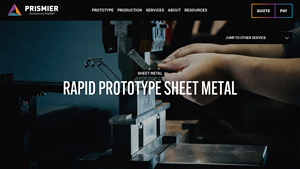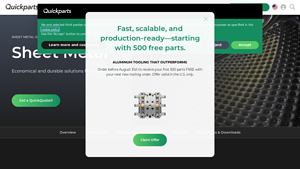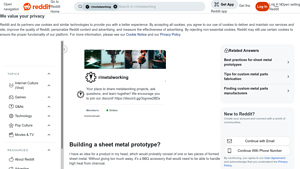Sheet Metal Prototype Fabrication Guide: Type, Cost, Top List…
Introduction: Navigating the Global Market for sheet metal prototype fabrication
In an increasingly competitive landscape, sourcing high-quality sheet metal prototype fabrication services can be a daunting challenge for international B2B buyers. The need for rapid prototyping without compromising on quality is essential for businesses aiming to bring innovative products to market swiftly. This guide is meticulously designed to address key aspects of sheet metal prototype fabrication, including various types of materials and processes, applications across industries, supplier vetting criteria, and cost considerations.
By providing a comprehensive overview, this resource equips buyers from regions such as Africa, South America, the Middle East, and Europe—including dynamic markets like Brazil and Vietnam—with the insights necessary to make informed purchasing decisions. Understanding the nuances of sheet metal fabrication—from laser cutting to advanced forming techniques—can significantly enhance a company’s ability to innovate and adapt to market demands.
Furthermore, this guide emphasizes the importance of establishing reliable partnerships with suppliers who can deliver precision and speed. With actionable strategies and critical factors outlined, international buyers will be empowered to navigate the complexities of the global market, ensuring they select the right fabrication services that align with their business objectives. By leveraging this guide, companies can streamline their procurement process, reduce lead times, and ultimately enhance their competitive edge in the global marketplace.
Understanding sheet metal prototype fabrication Types and Variations
| Type Name | Key Distinguishing Features | Primary B2B Applications | Brief Pros & Cons for Buyers |
|---|---|---|---|
| Laser Cutting | High precision, minimal heat-affected zones | Aerospace, automotive, electronics | Pros: Fast turnaround, intricate designs; Cons: Higher initial setup cost. |
| Water Jet Cutting | No thermal distortion, can cut thick materials | Heavy machinery, architecture, signage | Pros: Versatile, smooth edges; Cons: Slower than laser cutting for thin materials. |
| CNC Machining | Automated precision cutting and shaping | Custom tooling, industrial components | Pros: High accuracy, complex geometries; Cons: Longer lead times for setup. |
| Photo Chemical Etching | Chemical process for intricate and flat parts | Electronics, medical devices | Pros: Cost-effective for small runs; Cons: Limited to thin materials. |
| Stamping | High-volume production with dedicated tooling | Automotive, appliance manufacturing | Pros: Economical for large quantities; Cons: High initial tooling costs. |
What are the Characteristics of Laser Cutting in Sheet Metal Prototype Fabrication?
Laser cutting is a highly precise method that uses focused laser beams to cut through sheet metal. This technique is ideal for creating intricate designs with minimal heat distortion, making it suitable for applications in aerospace, automotive, and electronics. When considering laser cutting, businesses should evaluate the complexity of their designs and the required turnaround time, as this method typically offers fast production speeds.
How Does Water Jet Cutting Differ from Other Methods?
Water jet cutting utilizes a high-pressure stream of water, often mixed with abrasives, to cut through various materials, including thick metals. This method is particularly advantageous for applications in heavy machinery and architecture due to its ability to cut without thermal distortion. B2B buyers should consider water jet cutting for projects requiring precision and smooth finishes, keeping in mind that it may not be the fastest option for thinner materials.
What are the Benefits of CNC Machining for Prototype Parts?
CNC machining involves the automated removal of material to create complex shapes and designs. This method is favored for custom tooling and industrial components due to its high accuracy and ability to produce intricate geometries. However, businesses should be aware that CNC machining may involve longer lead times for setup compared to other methods, making it essential to plan ahead for production schedules.
Why Choose Photo Chemical Etching for Prototyping?
Photo chemical etching is a unique process that uses films and chemical etchants to create highly accurate flat metal parts. This method is particularly cost-effective for small production runs and is widely used in the electronics and medical device industries. Buyers should consider this option when looking for precision at a lower cost, but they must also note that this technique is limited to thinner materials.
What Makes Stamping an Economical Choice for High-Volume Production?
Stamping is a fabrication process that involves shaping metal using dedicated tooling, making it ideal for high-volume production runs. It is commonly used in the automotive and appliance manufacturing sectors. While stamping can significantly reduce per-unit costs for large quantities, businesses should factor in the initial investment in tooling, which can be substantial. This makes stamping a more viable option for companies with consistent production needs.
Key Industrial Applications of sheet metal prototype fabrication
| Industry/Sector | Specific Application of sheet metal prototype fabrication | Value/Benefit for the Business | Key Sourcing Considerations for this Application |
|---|---|---|---|
| Automotive | Production of custom brackets and mounts | Enhances vehicle performance and reduces weight | Material specifications, lead times, and tooling costs |
| Aerospace | Fabrication of complex components for aircraft | Improves safety and compliance with stringent standards | Certifications, precision tolerances, and material traceability |
| Electronics | Housing and enclosures for electronic devices | Provides durability and protection for sensitive parts | Custom designs, thermal management, and EMI shielding |
| Construction | Structural components for buildings and infrastructure | Increases strength and longevity of structures | Load-bearing capacity, corrosion resistance, and local regulations |
| Medical Devices | Prototyping surgical instruments and devices | Ensures reliability and compliance with health standards | Biocompatibility, precision requirements, and regulatory approvals |
How is Sheet Metal Prototype Fabrication Used in the Automotive Industry?
In the automotive sector, sheet metal prototype fabrication is crucial for producing custom brackets and mounts that enhance vehicle performance and reduce overall weight. These prototypes allow manufacturers to quickly iterate designs, ensuring that components fit perfectly and function optimally. For international buyers, particularly in regions like Africa and South America, it is essential to consider material specifications and the lead time for production to meet local market demands efficiently.
What Role Does Sheet Metal Prototype Fabrication Play in Aerospace?
Aerospace applications require the fabrication of complex components that adhere to strict safety standards. Sheet metal prototypes are utilized for parts such as brackets, panels, and housings, where precision and compliance are critical. For businesses in the Middle East and Europe, sourcing partners must have relevant certifications and the ability to maintain high precision tolerances while ensuring material traceability to meet regulatory requirements.
How is Sheet Metal Prototype Fabrication Beneficial for Electronics?
In the electronics industry, sheet metal prototype fabrication is employed to create housings and enclosures that protect sensitive electronic components from environmental factors. The durability and customizability of these prototypes help in thermal management and electromagnetic interference (EMI) shielding. Buyers in regions like Brazil and Vietnam should prioritize sourcing partners who can deliver custom designs quickly while ensuring the necessary thermal and EMI specifications are met.
What Advantages Does Sheet Metal Prototype Fabrication Offer in Construction?
The construction industry leverages sheet metal prototype fabrication to produce structural components that increase the strength and longevity of buildings and infrastructure. Prototypes can be used to test load-bearing capacities and ensure compliance with local regulations. For international buyers, particularly in developing regions, understanding corrosion resistance and local building codes is vital when selecting fabrication services to ensure safety and reliability.
How is Sheet Metal Prototype Fabrication Applied in Medical Devices?
In the medical field, sheet metal prototype fabrication is essential for developing surgical instruments and medical devices that require high reliability and adherence to health standards. Prototypes enable manufacturers to validate designs before mass production, ensuring biocompatibility and precision. Buyers, especially in emerging markets, should focus on sourcing manufacturers who can navigate regulatory approvals and deliver high-quality prototypes that meet stringent medical specifications.
3 Common User Pain Points for ‘sheet metal prototype fabrication’ & Their Solutions
Scenario 1: Tight Timelines for Prototype Development
The Problem: Many B2B buyers in industries such as automotive or aerospace face immense pressure to bring products to market quickly. Prototyping delays can hinder project timelines, resulting in lost revenue and missed opportunities. For instance, a company may require a series of sheet metal prototypes for product testing, but the lead times for fabrication are longer than anticipated, causing frustration and a potential domino effect on subsequent project phases.
The Solution: To overcome timeline challenges, it’s critical to partner with a fabrication service that prioritizes rapid prototyping. Look for providers that offer expedited services and transparent lead times. Utilizing technologies such as laser cutting and water jet cutting can significantly reduce production time. Additionally, consider adopting a flexible design approach that allows for quick iterations—submitting multiple designs at once can streamline the approval process. Establishing a robust communication channel with your fabricator ensures that any changes are promptly addressed, keeping the project on track.
Scenario 2: Complexity in Design Specifications
The Problem: Buyers often struggle with the complexity of their designs, particularly when intricate components are required. A lack of clarity in design specifications can lead to miscommunication with the fabrication team, resulting in prototypes that do not meet the required specifications or functionality. For example, a company may need precision-cut parts that must fit within a larger assembly but fails to convey the tolerances and material properties needed, leading to costly revisions.
The Solution: To mitigate this issue, it’s essential to provide detailed design documentation along with any CAD files. Clearly outline tolerances, material specifications, and finishing requirements in your initial communication with the fabricator. Utilizing prototyping software that simulates the fit and function of the design can also be beneficial. Engaging in collaborative design reviews with the fabrication team can help catch potential issues early in the process, ensuring that the final product aligns with expectations. Regular feedback loops and open dialogue will foster a more productive relationship and help streamline the fabrication process.
Scenario 3: Cost Management in Prototyping
The Problem: Cost control is a significant concern for many businesses, especially when dealing with multiple prototypes. Buyers often encounter unexpected expenses due to hidden costs in the fabrication process, such as tooling, material waste, or additional finishing services. For instance, a company might budget for a set number of prototypes but find that the costs escalate once they factor in additional processing, leading to budget overruns.
The Solution: To effectively manage costs, it’s important to engage in thorough upfront planning. Request a detailed quote that breaks down all potential costs, including material, processing, and any finishing services. Explore options for bulk orders or long-term contracts with your fabricator, as this can lead to lower pricing per unit. Additionally, consider using standardized designs where possible, as this can reduce complexity and associated costs. Implementing a prototype testing phase before full production can also help identify issues that may lead to costly modifications later on. By prioritizing cost transparency and exploring cost-effective solutions, buyers can maintain better control over their prototyping budgets.
Strategic Material Selection Guide for sheet metal prototype fabrication
What Are the Key Properties of Common Materials Used in Sheet Metal Prototype Fabrication?
When selecting materials for sheet metal prototype fabrication, it is essential to consider the specific properties that will influence product performance. Here, we analyze four common materials: Mild Steel, Stainless Steel, Aluminum, and Copper.
How Does Mild Steel Perform in Sheet Metal Prototyping?
Mild steel is a popular choice for sheet metal prototypes due to its excellent mechanical properties and cost-effectiveness. It has a high tensile strength and good ductility, making it suitable for various applications. Mild steel typically has a temperature rating of up to 400°F and offers moderate corrosion resistance, which can be enhanced through coatings.
Pros: Mild steel is durable, easy to machine, and relatively inexpensive, making it ideal for prototypes where cost is a significant concern. Its availability in various thicknesses and forms also adds to its versatility.
Cons: On the downside, mild steel is susceptible to rust and corrosion if not properly treated, which may limit its use in outdoor or humid environments. Additionally, its weight can be a disadvantage for applications requiring lightweight materials.
Impact on Application: Mild steel is compatible with various media, but its corrosion resistance may limit its use in environments with high moisture or corrosive substances.
Considerations for International Buyers: Compliance with standards such as ASTM A36 is crucial. Buyers from regions like Africa or South America should consider local availability and treatment options to enhance corrosion resistance.
What Are the Advantages of Stainless Steel in Prototyping?
Stainless steel is renowned for its corrosion resistance and aesthetic appeal. It is suitable for high-temperature applications, typically rated up to 1500°F, and offers excellent strength and durability.
Pros: The primary advantage of stainless steel is its resistance to corrosion, making it ideal for food processing, medical applications, and environments exposed to moisture. It also requires minimal maintenance.
Cons: However, stainless steel is more expensive than mild steel and can be more challenging to machine, which may increase manufacturing complexity and costs.
Impact on Application: Stainless steel is compatible with a wide range of media, including corrosive substances, making it a preferred choice for applications in the food and chemical industries.
Considerations for International Buyers: Compliance with standards like ASTM A240 or EN 10088 is essential. Buyers in Europe and the Middle East should be aware of local regulations regarding food-grade materials.
Why Choose Aluminum for Sheet Metal Prototyping?
Aluminum is favored for its lightweight properties and excellent corrosion resistance. It typically has a temperature rating of around 300°F and is known for its high strength-to-weight ratio.
Pros: The lightweight nature of aluminum makes it ideal for applications where weight savings are critical, such as in automotive and aerospace industries. Additionally, aluminum can be easily anodized for enhanced corrosion resistance.
Cons: The main drawback is its higher cost compared to mild steel. Aluminum can also be less durable under high-stress conditions compared to steel.
Impact on Application: Aluminum is compatible with various media, including water and chemicals, making it versatile for many applications.
Considerations for International Buyers: Buyers should consider compliance with standards like ASTM B209. In regions like Brazil and Vietnam, understanding local sourcing options for aluminum is vital due to varying availability.
What Role Does Copper Play in Sheet Metal Prototyping?
Copper is known for its excellent electrical conductivity and thermal properties. It is often used in electrical applications and has a temperature rating of up to 2000°F.
Pros: The primary advantage of copper is its superior conductivity, making it ideal for electrical components. It is also resistant to corrosion in many environments.
Cons: However, copper is more expensive than other metals and can be challenging to work with due to its softness.
Impact on Application: Copper is particularly suitable for applications requiring electrical conductivity, such as wiring and electronic components.
Considerations for International Buyers: Compliance with standards like ASTM B152 is important. Buyers in regions with high humidity should consider the potential for oxidation and corrosion.
Summary Table of Material Selection for Sheet Metal Prototype Fabrication
| Material | Typical Use Case for sheet metal prototype fabrication | Key Advantage | Key Disadvantage/Limitation | Relative Cost (Low/Med/High) |
|---|---|---|---|---|
| Mild Steel | General fabrication, automotive parts | Cost-effective and durable | Susceptible to rust | Low |
| Stainless Steel | Food processing, medical equipment | Excellent corrosion resistance | Higher cost and machining complexity | High |
| Aluminum | Aerospace, automotive, lightweight structures | Lightweight and corrosion-resistant | More expensive and less durable | Medium |
| Copper | Electrical components, wiring | Superior electrical conductivity | High cost and machining difficulty | High |
In-depth Look: Manufacturing Processes and Quality Assurance for sheet metal prototype fabrication
What Are the Key Stages in the Manufacturing Process of Sheet Metal Prototype Fabrication?
The manufacturing process for sheet metal prototype fabrication typically involves several key stages: material preparation, forming, assembly, and finishing. Each stage is critical for ensuring the final product meets the desired specifications and quality standards.
Material Preparation: How Is Raw Material Selected and Processed?
Material preparation is the first step in the fabrication process. Selecting the right type of metal—such as aluminum, stainless steel, or carbon steel—depends on the intended application and performance requirements. Once the material is chosen, it is typically cut to size using methods like laser cutting or water jet cutting. These techniques provide precision and minimize waste.
In addition to cutting, the material may undergo surface treatment to enhance its properties. For instance, certain metals might be anodized or coated to improve corrosion resistance. This preparation stage is crucial, as the quality of the raw material directly impacts the overall performance of the prototype.
Forming: What Techniques Are Used for Shaping Sheet Metal?
After preparation, the next stage is forming, where the cut sheets are transformed into the desired shapes. Common techniques include bending, stamping, and deep drawing. Bending involves applying force to create angles and curves, while stamping uses dies to produce complex shapes quickly and efficiently.
Advanced technologies like CNC (Computer Numerical Control) machinery can enhance precision in the forming process. This allows for intricate designs to be produced consistently, which is vital for prototypes that require exact specifications.
Assembly: How Are Different Components Joined Together?
The assembly stage involves putting together various parts that may have been fabricated separately. Techniques such as welding, riveting, or using fasteners are common. The choice of joining method depends on the strength and durability required for the final product.
In some cases, manufacturers may also incorporate hardware insertion during this stage to prepare the parts for final assembly. This can include installing nuts, bolts, or other components that will be necessary for the prototype’s functionality.
Finishing: What Are the Final Touches Applied to Prototypes?
Finishing is the last step in the manufacturing process and is essential for both aesthetic and functional reasons. Techniques such as powder coating, painting, or plating are employed to enhance the appearance and protect the metal from environmental factors.
Additionally, finishing processes can also include deburring and polishing, which remove sharp edges and improve surface quality. These steps are particularly important for prototypes that will be subjected to user interaction or harsh conditions.
What Quality Assurance Measures Are Important in Sheet Metal Prototype Fabrication?
Quality assurance (QA) is a critical aspect of sheet metal prototype fabrication, ensuring that products meet international standards and customer expectations. B2B buyers should be aware of various QA processes and certifications that can affect their purchasing decisions.
Which International Standards Should B2B Buyers Consider?
International standards such as ISO 9001 play a vital role in quality management systems. This standard ensures that organizations consistently provide products that meet customer and regulatory requirements. For the sheet metal industry, adherence to ISO 9001 can be indicative of a supplier’s commitment to quality.
In addition to ISO standards, industry-specific certifications may be relevant, such as CE marking for products sold in the European market or API standards for the oil and gas sector. These certifications can provide additional assurance regarding the quality and safety of products.
What Are the Key Quality Control Checkpoints Throughout the Manufacturing Process?
Quality control checkpoints are integrated throughout the manufacturing process to identify and address issues early. The typical checkpoints include:
- Incoming Quality Control (IQC): This involves inspecting raw materials upon arrival to ensure they meet specified standards.
- In-Process Quality Control (IPQC): During the manufacturing process, regular inspections are conducted to monitor quality and adherence to specifications.
- Final Quality Control (FQC): Once production is complete, a thorough inspection is performed to verify that the final product meets all requirements.
These checkpoints help minimize defects and ensure that only high-quality products are delivered to customers.
What Common Testing Methods Are Used to Validate Quality?
Testing methods vary depending on the specific requirements of the prototypes. Common approaches include:
- Dimensional Inspection: Verifying the measurements of the prototype to ensure they align with design specifications.
- Non-Destructive Testing (NDT): Techniques such as ultrasonic testing or X-ray inspection are used to identify internal defects without damaging the product.
- Functional Testing: Assessing the prototype’s performance in real-world conditions to ensure it operates as intended.
These testing methods provide valuable insights into the quality and reliability of the prototypes.
How Can B2B Buyers Verify Supplier Quality Assurance?
B2B buyers must take proactive steps to verify the quality assurance measures of their suppliers. Here are some recommended practices:
What Should Be Included in Supplier Audits?
Conducting supplier audits is an effective way to assess a manufacturer’s quality management system. Audits should cover:
- Quality Management Practices: Review the supplier’s adherence to international standards and internal QA processes.
- Facility Conditions: Inspect the manufacturing environment to ensure it meets necessary safety and cleanliness standards.
- Employee Training: Evaluate the training programs in place to ensure staff are knowledgeable about quality practices.
How Can Buyers Access Quality Reports and Certifications?
Buyers should request documentation from suppliers that outlines their quality assurance processes, including any relevant certifications and test results. Regular quality reports can provide ongoing insights into a supplier’s performance and help maintain accountability.
Why Are Third-Party Inspections Important for International Buyers?
For international buyers, engaging third-party inspection services can provide an additional layer of assurance. These independent organizations can conduct thorough inspections and testing, ensuring compliance with international standards and providing unbiased assessments of product quality.
What Are the Unique Quality Control Considerations for International Buyers?
International B2B buyers, particularly those from Africa, South America, the Middle East, and Europe, should be aware of specific nuances in quality control:
- Regulatory Compliance: Different regions may have varying regulatory requirements that must be adhered to. Understanding these regulations is crucial for successful market entry.
- Cultural Differences: Communication barriers may exist, so it’s vital to establish clear expectations and quality standards with suppliers.
- Logistical Challenges: International shipping can introduce risks related to damage or delays, making thorough inspections before shipment essential.
By addressing these considerations, international buyers can ensure they receive high-quality sheet metal prototypes that meet their needs and expectations.
Practical Sourcing Guide: A Step-by-Step Checklist for ‘sheet metal prototype fabrication’
Introduction
In the competitive landscape of manufacturing, sourcing sheet metal prototype fabrication efficiently is vital for bringing products to market quickly and effectively. This checklist serves as a practical guide for B2B buyers to streamline their procurement process, ensuring they select the right suppliers and materials while minimizing risks and costs.
Step 1: Define Your Technical Specifications
Establishing clear technical specifications is the foundation of your sourcing process. This includes dimensions, tolerances, material types, and finishing requirements. Providing comprehensive details will help suppliers understand your needs and deliver accurate prototypes that meet your expectations.
- Material Requirements: Specify the type of sheet metal (e.g., aluminum, stainless steel) and any required certifications (e.g., ASTM standards).
- Design Complexity: Include information about intricate designs or features that may require specialized fabrication techniques.
Step 2: Research and Identify Potential Suppliers
Conduct thorough research to compile a list of potential suppliers that specialize in sheet metal prototyping. Look for manufacturers with a proven track record in your industry to ensure they can meet your specific needs.
- Online Directories: Utilize platforms like ThomasNet or Maker’s Row to find reputable suppliers.
- Industry Connections: Leverage professional networks or trade shows to gather recommendations.
Step 3: Evaluate Supplier Capabilities
Before committing, assess each supplier’s capabilities to ensure they align with your project requirements. This includes evaluating their technology, production processes, and the range of services offered.
- Cutting and Forming Technologies: Confirm that they use advanced methods such as laser cutting or water jet cutting for precision.
- Post-Processing Services: Look for suppliers that offer additional services like anodizing or powder coating to meet your finishing needs.
Step 4: Request Quotes and Compare Pricing
Once you’ve narrowed down potential suppliers, request detailed quotes to compare pricing effectively. Ensure that each quote includes a breakdown of costs associated with materials, labor, and any additional services.
- Bulk Pricing: Inquire about discounts for larger orders to optimize your budget.
- Lead Times: Consider the production and delivery times to avoid delays in your project timeline.
Step 5: Verify Supplier Certifications and Quality Standards
Quality assurance is crucial in sheet metal fabrication. Verify that your chosen suppliers adhere to industry standards and possess relevant certifications, such as ISO 9001.
- Quality Control Processes: Ask about their quality control measures and inspection processes to ensure consistent output.
- Customer Testimonials: Request references from previous clients to gauge their reliability and product quality.
Step 6: Conduct a Site Visit or Virtual Audit
If possible, conduct a site visit or a virtual audit of the supplier’s facility. This will provide insights into their operational capabilities and quality management systems.
- Equipment Condition: Assess the state of their machinery and technology to ensure they can handle your requirements.
- Workforce Expertise: Evaluate the skill level of their workforce and their experience with similar projects.
Step 7: Establish Clear Communication Channels
Effective communication is essential throughout the sourcing process. Establish clear channels for ongoing dialogue to address questions or concerns as they arise.
- Point of Contact: Designate a primary contact person for seamless communication.
- Regular Updates: Set expectations for regular updates on project status to maintain transparency and trust.
By following these steps, B2B buyers can make informed decisions when sourcing sheet metal prototype fabrication, ultimately leading to successful project outcomes and enhanced supplier relationships.
Comprehensive Cost and Pricing Analysis for sheet metal prototype fabrication Sourcing
What Are the Key Cost Components in Sheet Metal Prototype Fabrication?
Understanding the cost structure of sheet metal prototype fabrication is crucial for international B2B buyers. The primary cost components include materials, labor, manufacturing overhead, tooling, quality control (QC), logistics, and profit margin.
-
Materials: The type of metal—such as steel, aluminum, or brass—significantly impacts pricing. Specialty materials like titanium or carbon fiber can drive costs higher due to their unique properties and processing requirements. Buyers should consider both the cost of raw materials and the availability of these materials in their region.
-
Labor: Skilled labor is essential in sheet metal fabrication, particularly for complex designs that require precision cutting and forming. Labor costs can vary greatly depending on the local wage standards and the level of expertise required.
-
Manufacturing Overhead: This encompasses the indirect costs associated with running the fabrication facility, including utilities, equipment maintenance, and facility costs. Overhead can vary by region and facility, affecting the final pricing.
-
Tooling: Initial tooling costs can be substantial, especially for custom designs. These costs may be amortized over larger production runs, making it vital to consider the volume of parts when negotiating prices.
-
Quality Control: Ensuring that parts meet specific tolerances and certifications often involves additional QC processes, which can increase costs. Buyers should inquire about the quality standards adhered to by the supplier.
-
Logistics: Transportation costs, including shipping and customs duties, can vary widely depending on the supplier’s location and the buyer’s location. Understanding Incoterms can help clarify responsibilities and costs associated with shipping.
-
Margin: Finally, suppliers will incorporate their desired profit margin into the price. This can vary based on market competition and the supplier’s own cost structure.
What Influences Pricing in Sheet Metal Prototype Fabrication?
Several factors can influence pricing in the sheet metal fabrication sector, particularly for international buyers.
-
Volume and Minimum Order Quantities (MOQ): Bulk orders often result in lower unit prices due to economies of scale. However, low MOQs can make it easier for smaller businesses to access prototypes without significant upfront investment.
-
Specifications and Customization: Highly customized parts often require additional engineering and setup time, leading to higher costs. Buyers should balance their design requirements with budget constraints.
-
Material Selection: As mentioned, different materials come with different cost implications. Additionally, the choice of surface finishes (like anodizing or powder coating) can also add to the overall cost.
-
Quality and Certifications: Parts that require specific certifications (such as ISO or ASTM standards) may incur additional costs related to compliance and testing.
-
Supplier Factors: The reputation and reliability of the supplier can influence pricing. Established suppliers may charge more due to their proven track record, while emerging suppliers might offer lower prices to gain market share.
-
Incoterms: Understanding the shipping terms can greatly affect the total cost. Different Incoterms can shift responsibility for shipping costs and risk, which can impact overall pricing.
How Can Buyers Optimize Costs in Sheet Metal Prototype Fabrication?
B2B buyers can implement several strategies to optimize costs in their procurement process:
-
Negotiate Prices: Leverage volume orders and long-term relationships to negotiate better pricing. Suppliers may offer discounts for repeat business or referrals.
-
Focus on Total Cost of Ownership (TCO): Look beyond initial pricing to consider factors such as durability, maintenance costs, and potential supply chain issues. This holistic view can lead to better long-term value.
-
Understand Regional Pricing Nuances: Prices can vary significantly between regions due to labor costs, material availability, and shipping logistics. Buyers should conduct market research to understand these dynamics in their target regions.
-
Consider Local Suppliers: Sourcing from local suppliers can reduce logistics costs and lead times, making it a viable option for many businesses.
In conclusion, understanding the complex pricing structure and cost components of sheet metal prototype fabrication is vital for international B2B buyers. By leveraging this knowledge and considering the various influencing factors, buyers can make informed decisions that align with their business goals. Always keep in mind that prices can vary significantly based on numerous factors, so it’s prudent to obtain multiple quotes and conduct thorough due diligence before committing to a supplier.
Alternatives Analysis: Comparing sheet metal prototype fabrication With Other Solutions
When evaluating sheet metal prototype fabrication, it is crucial to consider alternative manufacturing methods that can fulfill similar objectives. Each method offers distinct advantages and challenges that can impact production timelines, costs, and overall project outcomes. Below, we compare sheet metal prototype fabrication with two viable alternatives: 3D printing and injection molding.
| Comparison Aspect | Sheet Metal Prototype Fabrication | 3D Printing | Injection Molding |
|---|---|---|---|
| Performance | High precision and durability for complex parts | Good for intricate designs, but may lack strength | Excellent for high-volume production with consistent quality |
| Cost | Moderate for low volumes; cost-effective at scale | Lower initial costs, but expensive for large volumes | High initial tooling costs, but low per-unit cost at scale |
| Ease of Implementation | Requires CAD files; quick turnaround | Simple file upload; versatile material options | Complex setup; requires molds and tooling |
| Maintenance | Low; minimal upkeep required | Low; depends on printer type | High; molds may require frequent maintenance |
| Best Use Case | Prototyping for complex, functional parts | Rapid prototyping and low-volume production | High-volume production of uniform parts |
What Are the Advantages and Disadvantages of 3D Printing Compared to Sheet Metal Prototype Fabrication?
3D printing, or additive manufacturing, excels in creating complex geometries that would be difficult or impossible with traditional methods. It allows for rapid prototyping, enabling designers to test and iterate quickly. However, while 3D-printed parts can be produced with a variety of materials, they may lack the strength and durability required for some applications, making them less suitable for final products that undergo significant stress or wear.
How Does Injection Molding Compare to Sheet Metal Prototype Fabrication?
Injection molding is ideal for high-volume production runs, as it produces consistent and high-quality parts at a lower cost per unit after the initial investment in molds. However, the upfront costs for tooling can be prohibitively high, especially for small runs or prototypes. Injection molding also has a longer lead time due to the need for mold creation, making it less suitable for rapid prototyping compared to sheet metal fabrication.
How Can B2B Buyers Select the Right Prototyping Method for Their Needs?
When choosing between these methods, B2B buyers should carefully assess their specific project requirements. If rapid iteration and design complexity are paramount, 3D printing may be the best choice. For projects that require robust, functional prototypes, sheet metal fabrication offers a balance of speed and durability. Conversely, if the goal is to produce a large volume of identical parts with a focus on long-term cost-effectiveness, injection molding could be the optimal solution. Understanding the unique characteristics of each method will empower buyers to make informed decisions that align with their production goals and budgetary constraints.
Essential Technical Properties and Trade Terminology for sheet metal prototype fabrication
What Are the Key Technical Properties in Sheet Metal Prototype Fabrication?
Understanding the critical specifications in sheet metal prototype fabrication is essential for B2B buyers looking to streamline production processes and ensure product quality. Here are some key technical properties:
-
Material Grade
Material grade refers to the specific classification of the metal being used, which directly influences its strength, durability, and suitability for various applications. Common grades include A36 for mild steel, 5052 for aluminum, and 304 or 316 for stainless steel. Selecting the right material grade is crucial for meeting performance requirements and ensuring compliance with industry standards. -
Tolerance
Tolerance indicates the allowable variation in dimensions and specifications of the fabricated parts. For instance, a tolerance of ±0.005 inches means that the final product can be 0.005 inches larger or smaller than the specified size. In B2B contexts, tighter tolerances are often essential for parts that must fit together precisely, reducing the risk of assembly issues and ensuring the functionality of the final product. -
Thickness
The thickness of the sheet metal can significantly affect the part’s strength, weight, and cost. Thicker materials may provide greater durability but can also increase weight and production costs. Understanding the required thickness for specific applications allows businesses to optimize material usage and manage expenses effectively. -
Surface Finish
Surface finish refers to the texture and quality of the metal’s exterior after fabrication, impacting both aesthetics and functionality. Common finishes include anodizing, powder coating, and plating. A high-quality surface finish can enhance corrosion resistance and provide a more appealing appearance, which is particularly important in consumer-facing products. -
Forming Techniques
Various forming techniques, such as bending, stamping, and dimple forming, are used to shape the metal into the desired configuration. Each technique offers different advantages in terms of speed, cost, and complexity. Understanding which forming methods are most suitable for specific designs can help businesses achieve their production goals more efficiently.
What Are the Common Trade Terms in Sheet Metal Prototype Fabrication?
Familiarity with industry terminology is crucial for effective communication and negotiation in B2B transactions. Here are some common terms:
-
OEM (Original Equipment Manufacturer)
An OEM refers to a company that produces parts or equipment that may be marketed by another manufacturer. In the sheet metal industry, OEMs often require high-quality prototypes to validate designs before mass production, emphasizing the importance of precision and reliability in fabrication. -
MOQ (Minimum Order Quantity)
MOQ is the smallest quantity of a product that a supplier is willing to sell. In sheet metal fabrication, MOQs can affect inventory management and cost efficiency. Understanding MOQ requirements helps businesses plan their orders and manage production schedules effectively. -
RFQ (Request for Quotation)
An RFQ is a standard business process where a buyer requests pricing and terms from suppliers for specific products or services. For sheet metal prototypes, submitting an RFQ allows buyers to compare quotes from different suppliers, ensuring they receive competitive pricing and terms. -
Incoterms (International Commercial Terms)
Incoterms are internationally recognized rules that define the responsibilities of buyers and sellers in the shipping process. Understanding these terms is crucial for managing logistics and ensuring that all parties are aware of their obligations regarding shipping, insurance, and customs clearance. -
Lead Time
Lead time refers to the duration from the initiation of an order to its completion. In sheet metal prototype fabrication, shorter lead times can significantly impact a company’s ability to bring products to market swiftly. Being aware of lead times allows businesses to plan their production cycles and manage customer expectations effectively.
By grasping these technical properties and trade terms, B2B buyers can make informed decisions that enhance their operational efficiency and product quality in sheet metal prototype fabrication.
Navigating Market Dynamics and Sourcing Trends in the sheet metal prototype fabrication Sector
What Are the Key Trends Shaping the Global Sheet Metal Prototype Fabrication Market?
The sheet metal prototype fabrication market is currently experiencing a dynamic transformation driven by several global factors. Rapid technological advancements, such as the adoption of automation and artificial intelligence, are streamlining production processes and enhancing precision. International B2B buyers, particularly in emerging markets like Africa, South America, the Middle East, and Europe, are increasingly seeking suppliers who can offer rapid prototyping services. This demand is fueled by the need for faster time-to-market cycles, allowing companies to iterate designs quickly and effectively respond to consumer feedback.
Moreover, the trend of customization is gaining traction. Businesses are looking for flexible manufacturing solutions that can accommodate unique designs and specifications without imposing minimum order quantities. This shift is particularly beneficial for smaller enterprises that require bespoke solutions to differentiate themselves in competitive markets. Additionally, the rise of digital platforms for instant pricing and order management is revolutionizing how companies source their sheet metal prototypes, allowing for greater transparency and efficiency in procurement processes.
How Is Sustainability Influencing Sourcing Decisions in Sheet Metal Prototype Fabrication?
Sustainability is becoming a critical factor in the sourcing strategies of international B2B buyers. The environmental impact of manufacturing processes is under increasing scrutiny, prompting companies to prioritize ethical sourcing and sustainable practices. Buyers are now more inclined to partner with suppliers who demonstrate a commitment to reducing their carbon footprint and minimizing waste throughout the production cycle.
In the sheet metal prototype fabrication sector, the use of recycled materials and eco-friendly coatings is gaining momentum. Buyers should actively seek suppliers who can provide certifications for green materials and processes, as these credentials serve as indicators of a supplier’s commitment to sustainability. Furthermore, adopting practices such as energy-efficient manufacturing and waste reduction not only enhances a company’s reputation but can also lead to cost savings in the long run. The integration of sustainability into the supply chain is no longer optional; it is essential for maintaining competitiveness in a global marketplace increasingly focused on environmental stewardship.
How Has the Sheet Metal Prototype Fabrication Sector Evolved Over Time?
The evolution of the sheet metal prototype fabrication sector can be traced back to traditional manual methods of metalworking, which have gradually transformed into highly automated and technology-driven processes. Early methods relied heavily on manual labor and rudimentary tools, resulting in longer lead times and limited design capabilities. The advent of laser cutting and CNC machining revolutionized the industry, enabling manufacturers to achieve higher precision and efficiency.
Today, the sector is marked by the integration of advanced technologies such as water jet cutting and micro-cutting, which allow for the production of intricate designs with minimal material waste. This evolution has not only improved the quality of prototypes but has also expanded the range of materials that can be used in fabrication. As the market continues to evolve, the focus on rapid prototyping and the incorporation of sustainable practices will likely define the future landscape of sheet metal fabrication, making it essential for B2B buyers to stay informed and agile in their sourcing strategies.
Frequently Asked Questions (FAQs) for B2B Buyers of sheet metal prototype fabrication
-
How do I ensure quality in sheet metal prototype fabrication?
To ensure quality in sheet metal prototype fabrication, start by selecting a reputable supplier with a proven track record. Request samples of previous work and inquire about their quality assurance processes, including material certifications and inspection methods. Additionally, establish clear communication regarding your specifications and expectations. Engaging in regular updates and reviews during the production process can also help identify any issues early on, ensuring that the final product meets your standards. -
What is the best material for sheet metal prototypes?
The best material for your sheet metal prototypes depends on your specific application and requirements. Common materials include aluminum for its lightweight and corrosion resistance, stainless steel for its durability and strength, and cold-rolled steel for cost-effectiveness. Consider factors like weight, strength, corrosion resistance, and the intended environment of use. Discuss your needs with your fabricator, who can recommend the most suitable material based on their expertise and available resources. -
What are the typical lead times for sheet metal prototype fabrication?
Lead times for sheet metal prototype fabrication can vary significantly based on complexity, material availability, and the supplier’s capabilities. Generally, you can expect turnaround times ranging from a few days to several weeks. For urgent projects, some manufacturers offer expedited services. It’s crucial to communicate your deadlines clearly and confirm the expected delivery date upfront to avoid delays in your project timeline. -
Are there minimum order quantities (MOQ) for sheet metal prototypes?
Many sheet metal fabrication suppliers have flexible policies regarding minimum order quantities. While some may require a minimum order for cost-effectiveness, others, particularly those focused on prototyping, may accommodate single-unit orders. When sourcing suppliers, inquire about their MOQ policies to ensure they align with your project needs, especially if you are testing designs before larger production runs. -
How can I vet potential suppliers for sheet metal fabrication?
Vetting potential suppliers involves researching their reputation, capabilities, and customer feedback. Start by checking their website, reading reviews, and asking for references from past clients. Assess their technical capabilities by inquiring about their machinery, materials, and quality assurance processes. Additionally, requesting quotes and samples can help evaluate their responsiveness and product quality, giving you confidence in their ability to meet your requirements. -
What payment terms should I expect when sourcing sheet metal prototypes?
Payment terms can vary widely among suppliers, but most will require a deposit upfront, especially for custom work. Standard terms might include a 30% deposit upon order confirmation, with the remaining balance due before shipment. Some suppliers may offer net terms for established businesses. Always clarify payment terms and conditions in your contract to avoid misunderstandings and ensure smooth transactions. -
What are the key logistics considerations for international sheet metal fabrication?
When sourcing sheet metal prototypes internationally, consider logistics factors such as shipping costs, lead times, and customs regulations. Work with suppliers who provide detailed shipping options and track their shipments to avoid delays. Understand the import duties and taxes applicable in your country to budget effectively. Collaborating with a logistics partner experienced in international trade can streamline this process and ensure compliance with local regulations. -
How can I customize my sheet metal prototype design?
Customizing your sheet metal prototype design typically involves collaborating closely with your fabricator. Share your design files, such as CAD drawings, and specify any unique requirements, including dimensions, materials, and finishing options. Many suppliers offer online tools to visualize and adjust your design in real-time. Ensure to communicate any specific functionalities or aesthetic preferences to achieve a prototype that meets your expectations.
Important Disclaimer & Terms of Use
⚠️ Important Disclaimer
The information provided in this guide, including content regarding manufacturers, technical specifications, and market analysis, is for informational and educational purposes only. It does not constitute professional procurement advice, financial advice, or legal advice.
While we have made every effort to ensure the accuracy and timeliness of the information, we are not responsible for any errors, omissions, or outdated information. Market conditions, company details, and technical standards are subject to change.
B2B buyers must conduct their own independent and thorough due diligence before making any purchasing decisions. This includes contacting suppliers directly, verifying certifications, requesting samples, and seeking professional consultation. The risk of relying on any information in this guide is borne solely by the reader.
Top 7 Sheet Metal Prototype Fabrication Manufacturers & Suppliers List
1. Prototek – Sheet Metal Prototyping Services
Domain: prototek.com
Registered: 1996 (29 years)
Introduction: Prototek’s sheet metal prototyping services offer facilities throughout the USA, including bending & forming, laser cutting, waterjet cutting, welding, and assembly. They work with fabricated metals, plastics, and other materials. Key features include: 100+ materials, 40+ surface finishes, certifications (ISO 9001:2015, AS9100D, ITAR), in-house services (3D printing, CNC machining, urethane castin…
2. SendCutSend – Custom Sheet Metal Fabrication
Domain: sendcutsend.com
Registered: 2015 (10 years)
Introduction: SendCutSend offers custom sheet metal fabrication services including laser cutting, CNC routing, waterjet cutting, anodizing, bending & forming, countersinking, dimple forming, hardware insertion, plating, powder coating, tapping, tumbling, and deburring. They provide instant pricing for custom parts uploaded in STEP, DXF, or EPS formats, with no minimum quantities and free US shipping on orders o…
3. PCBWay – Custom Sheet Metal Fabrication Service
Domain: pcbway.com
Registered: 2012 (13 years)
Introduction: Sheet Metal Fabrication Service offers custom sheet metal parts and assemblies with a quick turnaround, as fast as 2 days. The service includes an easy-to-use online quoting system and ensures on-time shipment for orders ranging from single parts to 500 parts. The fabrication process involves bending, stretching, and material removal using press brake punches and die tooling. Typical products manu…
4. Protolabs – Sheet Metal Fabrication Service
Domain: protolabs.com
Registered: 2006 (19 years)
Introduction: Protolabs offers a Sheet Metal Fabrication service for prototyping that provides precision fabricated prototypes delivered in just days. Key features include: 1. Quick Quotes: Pricing and lead times available in minutes. 2. Fast Delivery: Parts can be on your desk by Friday if ordered on Monday. 3. Design for Manufacturability (DFM) Analysis: 3D-visualized feedback on potential manufacturing chall…
5. Prismier – Rapid Prototype Sheet Metal Services
Domain: prismier.com
Registered: 2003 (22 years)
Introduction: Rapid Prototype Sheet Metal services offered by Prismier include: 1. Fast turnaround for prototypes, with delivery in as little as 24 hours. 2. Dedicated in-house prototype cell stocked with common materials and gauges. 3. Design for Manufacturing (DFM) process to optimize parts for cost-effective manufacturing. 4. Production-caliber prototypes at prototype prices, allowing for true assessment of …
6. Quickparts – Sheet Metal Manufacturing Services
Domain: quickparts.com
Registered: 1997 (28 years)
Introduction: Sheet Metal Manufacturing services at Quickparts offer economical and durable solutions for a wide range of projects, from simple prototypes to complex multi-part assemblies. Key features include:
1. **Wide Range of Projects**: Supports various projects including bent sheet metal prototypes and production runs.
2. **Flexible Material**: Sheet metal can be cut, bent, or stretched into various shap…
7. Reddit – BBQ Accessory Prototype
Domain: reddit.com
Registered: 2005 (20 years)
Introduction: BBQ accessory made of one or two pieces of formed sheet metal; needs to handle high heat from charcoal; requires prototyping process; initial prototypes can be made from cardboard or heavy paper; consideration for using a steel fabricator for metal prototypes; potential use of high durability or high heat resistant plastics; importance of a solid business plan for marketing and distribution.
Strategic Sourcing Conclusion and Outlook for sheet metal prototype fabrication
In the rapidly evolving landscape of sheet metal prototype fabrication, strategic sourcing remains a critical factor for international B2B buyers seeking efficiency and quality. By leveraging advanced technologies such as laser cutting, water jet cutting, and CNC routing, companies can significantly reduce lead times while maintaining high precision. The ability to source custom parts quickly, with minimal minimum order quantities, empowers businesses to remain agile and responsive to market demands.
Buyers from regions like Africa, South America, the Middle East, and Europe should prioritize partnerships with manufacturers that offer comprehensive prototyping capabilities and rapid turnaround times. This approach not only facilitates better product development cycles but also enhances collaboration between design and manufacturing teams.
As we look to the future, the emphasis on innovation and sustainability in sheet metal fabrication will continue to grow. International buyers are encouraged to explore diverse sourcing options that align with their specific needs while considering the value of local suppliers who understand regional market dynamics. Embrace the opportunity to optimize your sourcing strategy today, ensuring you stay ahead in an increasingly competitive global marketplace.
